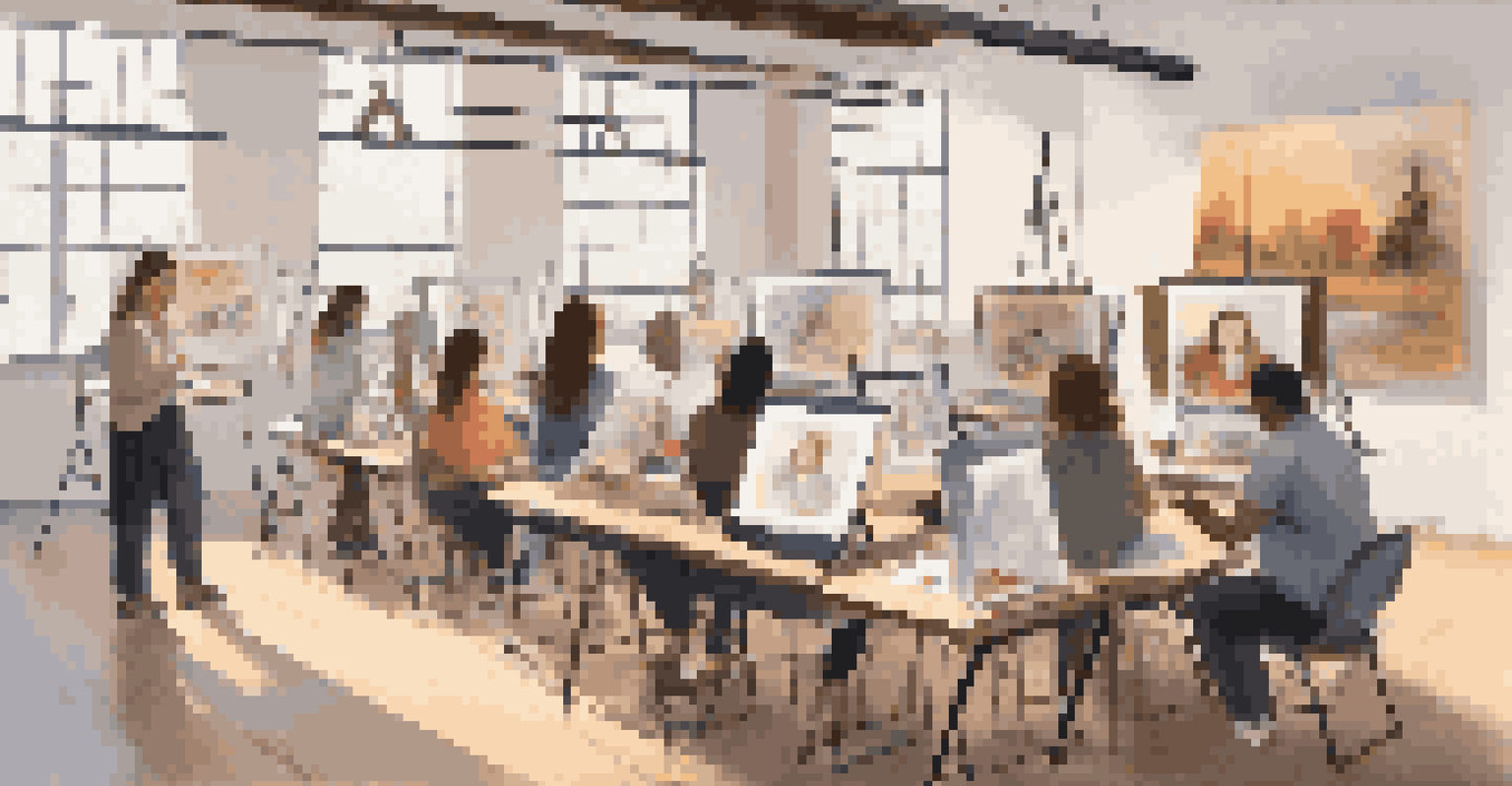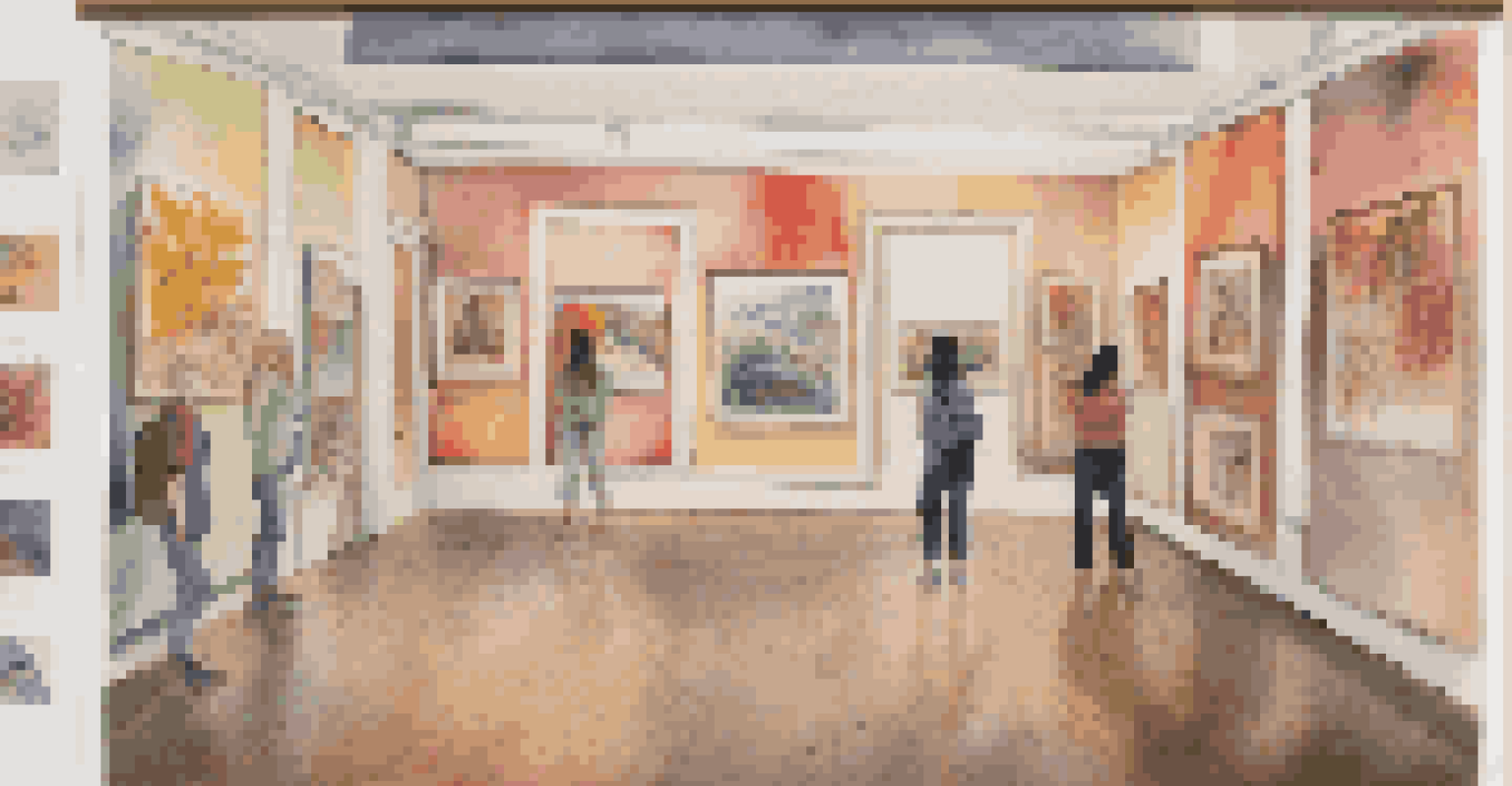Creating Virtual Art Communities for Student Collaboration

Understanding the Importance of Virtual Art Communities
In today's digital age, virtual art communities play a crucial role in fostering creativity and collaboration among students. These online spaces not only allow students to share their artwork but also to connect with like-minded peers, regardless of geographical barriers. By participating in these communities, students can receive feedback, gain inspiration, and develop their artistic skills in a supportive environment.
Art is the most beautiful of all lies.
Moreover, virtual art communities can help bridge the gap between different cultures and perspectives. When students from diverse backgrounds come together, they can share their unique experiences and artistic expressions, enriching the community as a whole. This exchange of ideas can lead to innovative projects and a deeper understanding of global art trends.
Ultimately, creating these communities encourages students to take ownership of their creative journeys. They learn to navigate online platforms, engage in constructive discussions, and build lasting relationships with fellow artists. This collaborative spirit not only enhances their artistic abilities but also prepares them for future team-based projects in their careers.
Choosing the Right Platform for Collaboration
Selecting the right platform is essential for fostering an effective virtual art community. Platforms like Discord, Slack, or even dedicated forums can provide the right environment for students to interact, share artwork, and collaborate on projects. The key is to choose a platform that is user-friendly and accessible to all participants.

Consider the specific needs of your community when choosing a platform. For example, if students prefer real-time communication, a platform with chat features and voice channels, like Discord, might be ideal. Alternatively, if the focus is on sharing work and receiving feedback, a platform that allows for easy image uploads and organized discussions, like a forum or a Facebook group, could be more suitable.
Fostering Creativity in Communities
Virtual art communities provide students with a platform to share artwork, receive feedback, and connect with peers, enhancing their creativity and collaboration.
Don't forget to consider privacy and safety features as well. Ensuring that students have a secure environment to express themselves is crucial. Look for platforms that offer moderation tools and settings that allow users to control their visibility and interactions.
Establishing Community Guidelines for Positive Interaction
Creating a set of community guidelines is vital for maintaining a respectful and supportive environment. These guidelines should outline expected behaviors, communication norms, and the consequences for inappropriate actions. By setting clear expectations, you can help foster a culture of respect and collaboration.
Creativity takes courage.
Encourage students to participate in the creation of these guidelines. This collaborative approach not only empowers them but also ensures that the rules reflect the values of the community. When students feel a sense of ownership over the guidelines, they're more likely to uphold them and contribute positively.
Regularly revisiting and revising these guidelines will also help address any emerging issues or concerns. This adaptability shows that the community values feedback and is committed to creating a safe space for all members.
Encouraging Diverse Artistic Expression
Encouraging diverse artistic expression is key to enriching a virtual art community. By embracing various styles, mediums, and cultural influences, students can learn from one another and expand their creative horizons. This variety fosters a dynamic environment where experimentation and innovation thrive.
Consider hosting themed challenges or exhibitions that celebrate different art styles or cultural traditions. These events not only inspire students to explore new techniques but also promote inclusivity within the community. For example, a 'Cultural Heritage Art Challenge' could invite students to create pieces that reflect their backgrounds, sparking conversations and connections.
Choosing the Right Collaboration Tools
Selecting user-friendly platforms like Discord or dedicated forums is essential for effective interaction and collaboration within virtual art communities.
Highlighting and celebrating individual contributions can also motivate students to share their unique perspectives. By showcasing different artists within the community, you create a sense of pride and belonging, encouraging everyone to participate and contribute.
Facilitating Meaningful Feedback and Critique
Constructive feedback is a critical component of artistic growth. Establishing a framework for providing and receiving feedback can help students feel more comfortable sharing their work. Encourage a culture of positivity where critiques focus on specific elements and offer solutions for improvement.
You might implement peer review sessions where students take turns giving and receiving feedback in a structured manner. This approach allows them to practice articulating their thoughts while also developing their critical thinking skills. Additionally, consider creating guidelines for what constitutes constructive feedback to guide students in their interactions.
Recognizing and celebrating achievements, no matter how small, can also enhance the feedback process. By acknowledging progress and effort, students will feel more motivated to engage and improve, paving the way for a supportive learning environment.
Hosting Virtual Events and Workshops
Virtual events and workshops can significantly enhance the experience within an art community. Hosting online workshops led by experienced artists or educators allows students to learn new techniques and explore different mediums in real-time. These interactive sessions can foster a sense of connection and collaboration among participants.
Consider organizing regular events, such as 'Art Jam' sessions where students create together while sharing tips and techniques. This informal setting can spark creativity and camaraderie, making the community feel more vibrant and engaging. Additionally, themed contests or exhibitions can motivate students to showcase their work and receive recognition.
Encouraging Diverse Artistic Expression
Embracing various artistic styles and cultural influences within the community fosters innovation and encourages students to explore their creativity.
Don't forget to promote these events effectively! Use social media channels, community newsletters, and direct messaging to keep everyone informed and excited about upcoming activities. Engaging events can draw in new members and keep the community thriving.
Evaluating Community Growth and Success
Evaluating the growth and success of your virtual art community is essential for continuous improvement. Regularly assess participation levels, engagement, and the overall satisfaction of members. Consider using surveys or feedback forms to gather insights on what is working well and what could be enhanced.
Metrics such as the number of active participants, frequency of events, and diversity of artwork shared can provide valuable data to inform your evaluation. This information not only helps identify trends but can also guide future planning and initiatives for the community.

Remember that growth may not always be linear. Embrace the ups and downs as part of the community's evolution. By remaining adaptable and responsive to feedback, you can ensure that the community continues to thrive and meet the needs of its members.